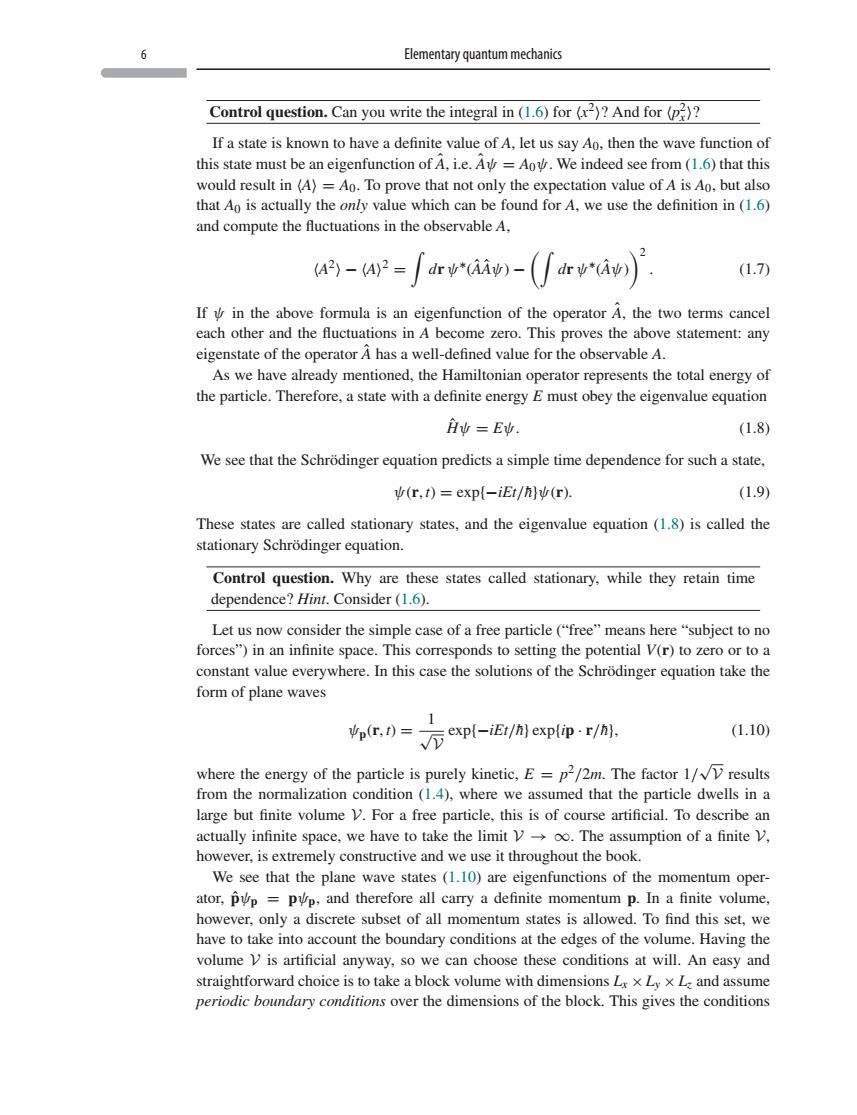正在加载图片...

6 Elementary quantum mechanics Control question.Can you write the integral in(1.6)for ()And for (p)? If a state is known tohavea definite value of.let us sayAo.then the wave function of this state must be an eigenfunction of A,i.e.Av=Aov.We indeed see from(1.6)that this would result in (A)=Ao.To prove that not only the expectation value of A is Ao.but also that Ao is actually the only value which can be found for A.we use the definition in(1.6) and compute the fluctuations in the observable a. 的-42=∫rg*ia-([r*aw. (1.7) If in the above formula is an eigenfunction of the operator A.the two terms cancel ons in A ome zer ro.This proves the above statement:any eigenstate of the operator A has a well-defined value for the observable A. As we have already mentioned,the Hamiltonian operator represents the total energy of the particle.Therefore,a state with a definite energy E must obey the eigenvalue equation Hv =Ev. (1.8 We see that the Schrodinger equation predicts a simple time dependence for such a state. (r.t)=exp(-iEt/)(r). (1.9) These states are called stationary states,and the eigenvalue equation (1.8)is called the stationary Schrodinger equation. Control question.Why are these states called stationary.while they retain time dependence?Hint.Consider(1.6). Let us now consider the simple case of a free particle("free"means here"subject to no forces")in an infinite space.This corresponds to setting the potential V(r)to zero or to a constant value everywhere.In this case the solutions of the Schrodinger equation take the form of plane waves p-iE/mep仰·rM. 1 (1.10) where the energy of the particle is purely kinetic.E =p2/2m.The factor 1/results from the normalization condition (1.4).where we assumed that the particle dwells in a large but finite volume V.For a free particle,this is of course artificial.To describe an we have the limity The assumption of a finite mely constructive and we use it throughout the bool We see that the plane wave states(1.10)are eigenfunctions of the momentum oper- ator,pvp =pyp,and therefore all carry a definite momentum p.In a finite volume however.only a discrete subset of all momentum states is allowed.To find this set.we have to take into ac count the boundary onditions at the edges of the volume.Having the An easy and straightforward choice is to take a block volume with dimensionsL Ly xL and assume periodic boundary conditions over the dimensions of the block.This gives the conditions6 Elementary quantum mechanics Control question. Can you write the integral in (1.6) for x2? And for p2 x ? If a state is known to have a definite value of A, let us say A0, then the wave function of this state must be an eigenfunction of Aˆ, i.e. Aˆψ = A0ψ. We indeed see from (1.6) that this would result in A = A0. To prove that not only the expectation value of A is A0, but also that A0 is actually the only value which can be found for A, we use the definition in (1.6) and compute the fluctuations in the observable A, A2−A 2 = dr ψ∗(AˆAˆψ) − dr ψ∗(Aˆψ) 2 . (1.7) If ψ in the above formula is an eigenfunction of the operator Aˆ, the two terms cancel each other and the fluctuations in A become zero. This proves the above statement: any eigenstate of the operator Aˆ has a well-defined value for the observable A. As we have already mentioned, the Hamiltonian operator represents the total energy of the particle. Therefore, a state with a definite energy E must obey the eigenvalue equation Hˆ ψ = Eψ. (1.8) We see that the Schrödinger equation predicts a simple time dependence for such a state, ψ(r, t) = exp{−iEt/h¯}ψ(r). (1.9) These states are called stationary states, and the eigenvalue equation (1.8) is called the stationary Schrödinger equation. Control question. Why are these states called stationary, while they retain time dependence? Hint. Consider (1.6). Let us now consider the simple case of a free particle (“free” means here “subject to no forces”) in an infinite space. This corresponds to setting the potential V(r) to zero or to a constant value everywhere. In this case the solutions of the Schrödinger equation take the form of plane waves ψp(r, t) = 1 √ V exp{−iEt/h¯} exp{ip · r/h¯}, (1.10) where the energy of the particle is purely kinetic, E = p2/2m. The factor 1/ √ V results from the normalization condition (1.4), where we assumed that the particle dwells in a large but finite volume V. For a free particle, this is of course artificial. To describe an actually infinite space, we have to take the limit V → ∞. The assumption of a finite V, however, is extremely constructive and we use it throughout the book. We see that the plane wave states (1.10) are eigenfunctions of the momentum operator, pˆψp = pψp, and therefore all carry a definite momentum p. In a finite volume, however, only a discrete subset of all momentum states is allowed. To find this set, we have to take into account the boundary conditions at the edges of the volume. Having the volume V is artificial anyway, so we can choose these conditions at will. An easy and straightforward choice is to take a block volume with dimensions Lx ×Ly ×Lz and assume periodic boundary conditions over the dimensions of the block. This gives the conditions��